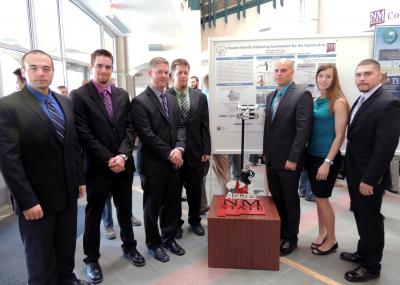NMSU engineering students showcase designs

The teams' presentations were evaluated by a panel of judges that included engineering faculty, representatives from Calculex, a local engineering firm owned by an NMSU alumnus, and other NMSU engineering alumni.
"The biggest benefit of doing this project was being able to work with a real engineer (adviser Ken Ruble) and developing something that may help the world someday," said David Williams, mechanical engineering senior. "It's nice to see people interested in what we're doing."
Their device, acting as a support beam to the arm, may be used in rehabilitation for injuries such as a dislocated shoulder.
This capstone project was part of a larger-scale body of research being conducted at NMSU's Reduced-Gravity and Biomechanical Lab.
The team, who won $500 for their effort, included Steven Stroup, Erin McMath, Fazzel Gurrola, Jacob Lovas, Reid Sharpe, David Williams and Stephanie. Their project was praised by judges for its "outstanding analysis backed by experiments."
All of the projects were the result of senior capstone projects, the culmination of the engineering curriculum and a requirement for graduation.
"The capstone course is extremely important because it is an all-integrating course that combines the foundation courses and the upper-division courses into a complete design from start to finish," said Associate Dean Sonya Cooper. "It demonstrates that students understand the relevance of all the other courses and have put their skills together to come up with a solution to a problem."
"The projects involve technical skills, teamwork, material procurement, analyzing alternatives, project management, drawing conclusions, and practicing written and verbal communication skills," said Cooper. "Because it's an all-integrating course, it allows the faculty to measure many student learning outcomes."
Taking second place and winning $300 was a team from aerospace engineering, which designed and manufactured a turbulent flow generator for the university's low speed wind tunnel. Referred to as "AGS," the Active Grid Systems will allow NMSU to monitor flows for more realistic and accurate modeling. Team members included Joe McDiarmid, Nilo Thomas, Logan Sandoval, Taylor Harris and Mark Perea.
Third place was taken by chemical engineering students who presented their project on the economic analysis of bio-mass pyrolysis vs. joint coal bio-mass gasification. Team members were Yingxi Chen, John D. Hjelte, Brian Patterson, Yi Win, Hope Quintana and Ziuhua Yang. They won $200.
This year was the first time students were given the opportunity to showcase their work to the public, and Cooper said it would not be the last.
"It was exciting for the students, and a crucial step," she explained. "They've taken their semester or year-long efforts and condensed them into a poster that a lay person can understand."
Other presentations included electrical engineering projects on amateur radios, an electronic building management system and hydropower energy recovery. Mechanical and aerospace engineering students presented projects on hybrid rocket ignition and vibration isolation sled design for high-speed test tracks. Civil engineering students projects focused on dam design and flood control. Engineering technology students showed their work on rocket design from the NASA Student Launch Initiative Competition. Chemical engineering student projects explored bio-mass to bio-fuel converters.
"It was an excellent experience and the feedback was great," said Cooper. "The college will continue to improve upon that."


